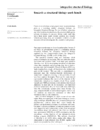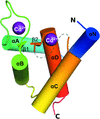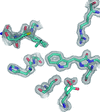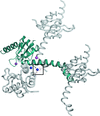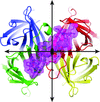issue contents
May 2013 issue
Including articles from the Integrated Software for Integrative Structural Biology workshop edited by Chris Morris

Cover illustration: A Chi60 chitinase molecule (p. 821) attached to the surface of chitin via its chitin-binding domain. The structure of Chi60 is crystallographic. The surface of chitin has been generated by expanding the known crystal structure of an N-acetyl glucosamine oligomer by the application of crystallographic symmetry. The association of Chi60 with the chitin surface is hypothetical. The inset shows the three surface tryptophan side chains of the chitin-binding domain in their hypothetical interaction with the chitin surface.
integrative structural biology
Open  access
access
 access
accessThe trends to investigate larger complexes and more transient phenomena pose some challenges to software developers.

Loading metrics information...
Download citation


Download citation



Loading metrics information...
In this research, the usefulness of low-resolution shape data for scoring docking decoys is explored. Within this context, a new scoring function is introduced that combines the regular HADDOCK score with either small-angle X-ray scattering or collision cross-section data.
This work describes three developments promoting integrative biology, standardization and workflow processing, namely PeppeR, the EMX initiative and Scipion.

Loading metrics information...
Download citation


Download citation



Loading metrics information...
Open  access
access
 access
accessCurrent developments in the computational structural biology framework OpenStructure are presented.
Open  access
access
 access
accessThe integration of structural data on atomistic to cellular scales with genetic, taxonomic and functional information is discussed. The challenges to the PDB and EMDB archives and some pertinent developments at PDBe to address these are discussed.
research papers

Loading metrics information...
Download citation


Download citation



Loading metrics information...
A 1.4 Å resolution crystal structure of wild-type human cardiac troponin C regulatory domain (cNTnC) in complex with Cd2+ is compared with structures of other EF-hand containing proteins that have been cocrystallized with Cd2+. Structures of cNTnC with disease-related mutations L29Q and NIQD (D2N/V28I/L29Q/G30G) are also determined.
PDB references: cNTnC, wild type, 3swb; 3sd6; refolded wild type, 4gje; L29Q mutant, 4gjf; NIQD mutant, 4gjg

Loading metrics information...
Download citation


Download citation



Loading metrics information...
The results of structural and functional characterizations of H. pylori HP0377, a thioredoxin-fold protein, are reported. HP0377 can reduce apocytochrome c553 (HP1227) and forms a covalent complex with a putative L,D-transpeptidase (HP0518) via a disulfide bond, suggesting that HP0377 may serve multiple functions as a reductase in H. pylori.

Loading metrics information...
Download citation


Download citation



Loading metrics information...
The crystal structure of the dimeric R298A mutant of SARS-CoV Mpro offers insights into the molecular mechanism controlling monomer–dimer conversion during the process of Mpro maturation.
PDB reference: SARS-CoV Mpro, R298A mutant, 4hi3

Loading metrics information...
Download citation


Download citation



Loading metrics information...
The first crystallographic structures of the c-Src SH3 domain in complex with two different high-affinity peptides have been solved at atomic resolution.

Loading metrics information...
Download citation


Download citation



Loading metrics information...
The high resolution X-ray structure of the cyan fluorescent protein mCerulean3 demonstrates that different combinations of correlated residue substitutions can provide near optimum quantum yield values for fluorescence.
PDB reference: mCerulean3, 4en1

Loading metrics information...
Download citation


Download citation



Loading metrics information...
The mitochondrial localization of BinCARD and the susceptibility to oxidation of all three of its cysteines suggest the possibility of a role in redox regulation.

Loading metrics information...
Download citation


Download citation



Loading metrics information...
Crystal structure of malaria parasite lysyl tRNA synthetase provides basis for drug development.
PDB reference: PfLysRS, 4h02
AutoDrug: fully automated macromolecular crystallography workflows for fragment-based drug discovery
New software has been developed for automating the experimental and data-processing stages of fragment-based drug discovery at a macromolecular crystallography beamline. A new workflow-automation framework orchestrates beamline-control and data-analysis software while organizing results from multiple samples.

Loading metrics information...
Download citation


Download citation



Loading metrics information...
The structures of Bacillus alcalophilus phosphoserine aminotransferase in the presence or absence of L-phosphoserine were determined at 1.5 and 1.6 Å resolution, respectively. Structural comparison revealed local conformational changes and the formation of a tight phosphate-binding site upon L-phosphoserine binding.

Loading metrics information...
Download citation


Download citation



Loading metrics information...
Open  access
access
 access
accessCrystal structures of the cytoplasmic domain of FlhB from S. typhimurium and A. aeolicus were solved at 2.45 and 2.55 Å resolution, respectively. The deletion of a short loop in the cytoplasmic domain of Salmonella FlhB completely abolishes secretion by the type III secretion system. A molecular-dynamics simulation shows that the deletion of the loop affects the flexibility of a linker between the transmembrane and cytoplasmic domains of FlhB.

Loading metrics information...
Download citation


Download citation



Loading metrics information...
Chitinase from a cold-adapted bacterium has been examined in the unliganded form and in complexes with the reaction intermediate and the reaction product. The structure, which consists of four linearly arranged domains, has been examined for features responsible for the activity, specificity and adaptation to low temperatures of the enzyme.

Loading metrics information...
Download citation


Download citation



Loading metrics information...
Open  access
access
 access
accessThe crystal structures of Arabidopsis Deg5 and Deg8 have been determined to resolutions of 2.6 and 2.0 Å, respectively, revealing novel structural features of HtrA proteases.

Loading metrics information...
Download citation


Download citation



Loading metrics information...
Analysis of serial femtosecond crystallographic data measured using the SACLA free-electron laser at RIKEN Harima shows the weak anomalous signal from naturally occurring S atoms in a protein.

Loading metrics information...
Download citation


Download citation



Loading metrics information...
The potential of second-harmonic generation (SHG) microscopy for automated crystal centering to guide synchrotron X-ray diffraction of protein crystals has been explored.
Electron imaging of three-dimensional protein nanocrystals using a Titan Krios electron microscope and a Falcon direct electron detector revealed structural details at higher than 3 Å resolution. Image processing with IMAGIC (cryo-EM single-particle analysis software) could improve the data to beyond 2 Å resolution.

Loading metrics information...
Download citation


Download citation



Loading metrics information...
Here, a case study of the effects of cryoprotectants on the kinetics of carbonic anhydrase II (CA II) and its inhibition by the clinically used inhibitor acetazolamide (AZM) is presented.

Loading metrics information...
Download citation


Download citation



Loading metrics information...
Structures of Enterovirus 71 3C proteinase (strain E2004104-TW-CDC) and its complex with rupintrivir
The crystal structures of Enterovirus 71 3C proteinase and its complex with rupintrivir are reported.
Standard ways for the placement of molecules in the unit cell are proposed.

Loading metrics information...
Download citation


Download citation



Loading metrics information...
The structure of the SBP-Tag–streptavidin complex reveals a novel mode of peptide recognition in which a single peptide binds simultaneously to biotin-binding pockets from adjacent subunits of streptavidin. The molecular details of peptide recognition suggest how the SBP-Tag can be further modified to become an even more useful tag for a wider range of biotechnological applications.
PDB reference: streptavidin complex with SBP-Tag, 4jo6

Loading metrics information...
Download citation


Download citation



Loading metrics information...
The de novo structure of coniferyl alcohol 9-O-methyltransferase and ITC measurements suggest a novel binding mode and reaction mechanism in plant small-molecule O-methyltransferases.

Loading metrics information...
Download citation


Download citation



Loading metrics information...
Open  access
access
 access
accessAnalysis of the crystal structures of the two milk-clotting enzymes bovine and camel chymosin has revealed that the better milk-clotting activity towards bovine milk of camel chymosin compared with bovine chymosin is related to variations in their surface charges and their substrate-binding clefts.
short communications

Loading metrics information...
Download citation


Download citation



Loading metrics information...
Information from structural genomics experiments has been compiled and published as an integrated database.

Loading metrics information...
Download citation


Download citation



Loading metrics information...
Open  access
access
 access
accessA novel high-throughput in situ plate-screening procedure is used to assess the effect of dehydration on a membrane-associated protein. In this case the dehydration improved the diffraction quality of the crystal.
books received
Free 



 journal menu
journal menu








